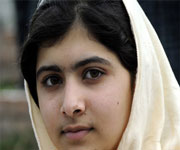Even as the joint statement from the team of doctors from the Queen Elizabeth and Birmingham Children's hospitals described Pakistan's teenage rights activist Malala Yousufzai's condition as "comfortable and stable" on Friday, a recent United Nations Educational, Scientific and Cultural Organisation (UNESCO) report revealed some startling facts about how the country has failed in protecting the right of education for girls and in reducing gender inequality.
Want to read UNESCO Daily News Updates? Click Here!!!
14-year-old Malala who was shot
 While Pakistan Government announced Sitara-e-Shujaat, one of country's highest civilian awards for bravery, to 14-year-old Malala who was shot in the head by the Taliban for speaking out against the militants, the UNESCO report stated that Pakistan, unlike others in the region such as India, Nepal and Bangladesh, has failed to reduce gender gaps over time. The report stated that there are over three million girls in Pakistan who are out of school. Indicating at the global outcry and support to Malala, Pauline Rose, director of the Global Monitoring Report (GMR) on Education for All (EFA) said: "It's tragic that it took violence for the world's attention to turn to the difficulties girls face in getting to school in Pakistan.
While Pakistan Government announced Sitara-e-Shujaat, one of country's highest civilian awards for bravery, to 14-year-old Malala who was shot in the head by the Taliban for speaking out against the militants, the UNESCO report stated that Pakistan, unlike others in the region such as India, Nepal and Bangladesh, has failed to reduce gender gaps over time. The report stated that there are over three million girls in Pakistan who are out of school. Indicating at the global outcry and support to Malala, Pauline Rose, director of the Global Monitoring Report (GMR) on Education for All (EFA) said: "It's tragic that it took violence for the world's attention to turn to the difficulties girls face in getting to school in Pakistan.In the Swat district, where Malala is from, less than a third of girls are enrolled in school, leaving two thirds at home with little chance of fulfilling their dream. It is also a scandal to ignore girls' education when we know it benefits not just that one girl, but also has a huge impact on their household's health and income, and ultimately the future peace and prosperity of their country."
According to the UNESCO's 10th Education for All Global Monitoring Report released on Tuesday, Pakistan is doing far worse in reducing gender gaps in comparison to other countries in the region. The report stated that 78% of the poorest girls were out of school in 1991 in Pakistan, a figure which has only reduced to just 62% today (around 2/3).
India, meanwhile, which had similar rates of the poorest girls out of school in 1992 (66%), has more than halved that to just 30% according to latest data. Likewise, Nepal has dropped the rates from 52% to 22% and Bangladesh from 44% to 9%. Rose said: "The news of the attack on Malala in Pakistan is a tragedy. She was standing up for the right of education for girls in the country, rights which are not yet being respected. There are still over three million girls out of school in the country today."
"This is not the first time that insurgent groups have attacked education infrastructure in Pakistan. Often, as seen in Afghanistan, girls' schools are a particular target. Failing to respond to such attacks as seen in Pakistan yesterday will only engender further fear among parents over sending their children to school, of children going to school and of teachers turning up to take classes," added Rose. According to the GMR statistics on Pakistan there are five million children out of school in Pakistan today; three million of them are girls. And just 31% of girls are enrolled in primary school in Swat District exactly who Malala was fighting for. According to EFA GMR analysis, 56% of poorest girls in Khyber-Pakhtunkhwa have never been to school.
"All too often, due to conflict, the education of girls and boys is left off the list of priorities. As such, over 40% of out of school children in the world are in conflict affected countries. These governments must prioritise the education of their future generations; the international community must do more to set aside vital funds in humanitarian aid for ensuring the schooling of girls and boys is not interrupted. Without an educated population, these countries will find it hard to build peace in the future," said Rose. According to the report, Pakistan's progress in closing the gap between the number of girls and boys getting the chance of an education is far too slow.
India, Nepal and Bangladesh Pakistan's neighbours have made huge inroads reducing these gender gaps and showing that they are doing far more to put girls at the centre. Bangladesh has done so well that girls are as numerous as boys in school. Revealing further the GMR report stated that Pakistan's spending on education is actually decreasing, rather than increasing, despite its low rates of enrolment in school. In 1999, the country spent 2.6% of its GNP in education. In 2010, it spent only 2.3%. And today, Pakistan is second only to Nigeria when it comes to the dubious distinction of having the highest number of out of school children in the world.









No comments:
Post a Comment